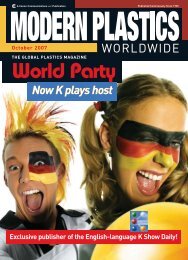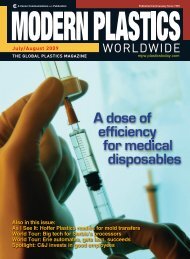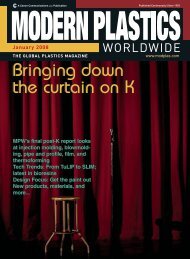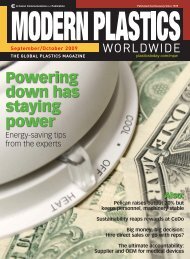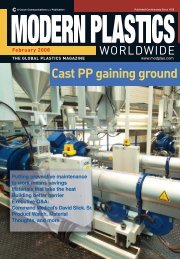amidiq - dae uptlax
amidiq - dae uptlax
amidiq - dae uptlax
Create successful ePaper yourself
Turn your PDF publications into a flip-book with our unique Google optimized e-Paper software.
338<br />
N. Martínez-Vázquez et al. / Revista Mexicana de Ingeniería Química Vol. 6, No. 3 (2007) 337-345<br />
chains, and the polymer’s disposition in the space.<br />
These physicochemical properties of the hydrogels<br />
depend on knowing a series of parameters: chemical<br />
composition, degree of crosslinking, presence of<br />
functional groups, and variety of solvents that are<br />
used. The volume phase transition of a<br />
thermosensitive gel was first published by Hirokawa<br />
and Tanaka (1984) for N-isopropylacrylamide<br />
(NIPAAm) gels in water upon increasing the<br />
temperature to above 33°C. This thermal dependency<br />
is due to the hydrophobic interaction between the<br />
polymer network and the water. At high<br />
temperatures, the network deflates and becomes<br />
more ordered, but the excluded water molecules<br />
become less ordered. The gel’s collapse increases the<br />
entire system’s entropy. Some hydrogels experience<br />
transition phases upon varying the dissolvent’s<br />
composition. An example of this type of behavior is<br />
observed in the swelling of NIPAAm and acrylamide<br />
(Aam) gels in dimethyl sulfoxide (DMSO) mixtures<br />
and water (Hirokawa et al., 1984).<br />
Ohmine and Tanaka (1982) and Brandon-<br />
Peppas (1990) observed the abrupt collapse of ionic<br />
networks in response to sudden changes in the<br />
swelling environment’s ionic force. It wasn’t until<br />
1990 that Grimshaw et al. developed a quantitative<br />
model to treat the swelling kinetics of gels sensitive<br />
to pH. Frusawa and Hayakawaalsky (1998) devised<br />
the first work on the dynamic swelling of pH<br />
sensitive networks, establishing that the collapse and<br />
expansion of poly-gels (methacrylic acid) (PMA)<br />
occur reversibly, adjusting the environment’s pH.<br />
Khare and Peppas (1995) studied the swelling<br />
kinetics of PMAAc and PAA, and observed that for<br />
these gels, they depend upon the pH and the ionic<br />
force.<br />
Escobar et al. (2001) carried out an in vitro<br />
study and preliminary evaluation of poly<br />
(acrylamide-co-methacrylic acid) hydrogel<br />
biocompatibility. They determined that as the<br />
acrylamide percentage diminishes, the swelling<br />
diminishes, due to the strong hydrophilic character<br />
supplied by the acrylamide units in the copolymer<br />
chains. In addition, as the pH increases from 4.0 to<br />
7.4, swelling is favored. The nature of water<br />
diffusion of said hydrogels has an anomalous<br />
character; that is to say that the diffusion processes<br />
and relaxation of chain tensions take place in the<br />
same time order, such that the greater the deviation<br />
with respect to the Fickian behavior, the more related<br />
the predomination of one process over the other is.<br />
For longer times, the swelling process is not<br />
governed by the diffusion, but rather by the<br />
relaxation, of the polymeric chains.<br />
The hydrogel studied is made of<br />
polyacrylamide (PAAm) and methyl cellulose (MC).<br />
The polyacrylamide hydrogels are transparent, with<br />
poor mechanical properties and are capable of<br />
retaining a great quantity of water depending on the<br />
percentage of crosslinking agent. An important<br />
advantage is that they are chemically inert and<br />
relatively stable under the physiological conditions<br />
of pH and temperature. Those that were synthesized<br />
from methyl cellulose upon increasing the catalyst<br />
(HCl) and crosslinking agent (glutaraldehyde)<br />
increase the degree of crosslinking and present a<br />
lower swelling degree. One of the factors that<br />
contributes to environmental contamination is the<br />
use of large quantities of non-degradable synthetic<br />
polymers. The polymer conserves its hydrophilic<br />
nature provided by the polyacrylamide, and the<br />
cellulose derivative (methyl cellulose) gives the<br />
hydrogel a certain degradation. The purpose of the<br />
project is to determine the effect of temperature and<br />
pH on the MC/PAAm hydrogel’s swelling kinetic, to<br />
substantiate the presence of the components, and to<br />
determine the thermal properties after swelling.<br />
2. Experimental part.<br />
2.1. Materials<br />
Acrylamide (Aam, Aldrich 97%), methyl<br />
cellulose (MC, Aldrich, Mw=40000. substitution<br />
grade of 1.6-1.9, methoxy), glutaraldehyde (GA,<br />
Merck- Schuchardt at 25% weight in water), and<br />
crosslinking agent: N, N’-methylene-bis-acrylamide<br />
(NNMBA, Aldrich 99% purity), potassium persulfate<br />
(Fischer- Chemical), HCl (Productos Químicos de<br />
Monterrey), and double/distilled water.<br />
2.2. Preparation of hydrogel<br />
A polymeric solution at 5% weight in AAm<br />
and MC was prepared at the temperature of 80 °C<br />
undergoing 30 minutes of constant stirring. The<br />
AAm and MC weight ratios were varied (Table 1).<br />
Subsequently, the GA at 2.5x10 –6 mol/mL and<br />
the HCl 2.25 x 10 –1 mol/L were added. Both<br />
concentrations were taken from Park et al., (2001);<br />
the crosslinker NNMBA and the K2S2O8 at their<br />
respective weight percentage ratios were taken at the<br />
same conditions during a reaction time of 2 hours.<br />
The reaction time having elapsed, the mixture was<br />
placed in a petri dish to carry out the gelling at 40 ºC<br />
and obtain the film. In Table 1, the ratios for<br />
preparing films with a weight of 2 g are shown; said<br />
ratios of MC/PAAm and variations of<br />
initiator/crosslinker were selected for their swelling<br />
degree at room temperature, which was superior to<br />
660%. Preliminary experiments demonstrated that<br />
the homogeneity depends on the percentage of<br />
polyacrylamide and cellulose derivates. When the<br />
PAAm percentages were greater than 20 wt%, the<br />
gel presented a non-homogeneous surface and the<br />
degree of swelling was under 500%.<br />
Table 1. Ratios used to prepare films with 2 g.<br />
% of % of % %<br />
Sample<br />
MC AAm Initiator Crosslinker<br />
MC/PAAm 1 80 20 0.5 wt% 1.0 wt%<br />
MC/PAAm2 90 10 1.0 wt% 0.5 wt%<br />
MC/PAAm3 80 20 1.0 wt% 1.0 wt%



